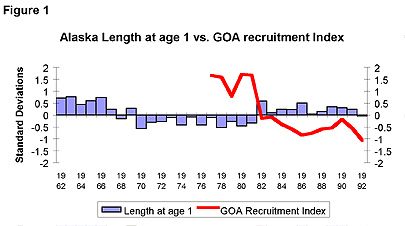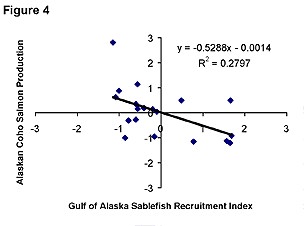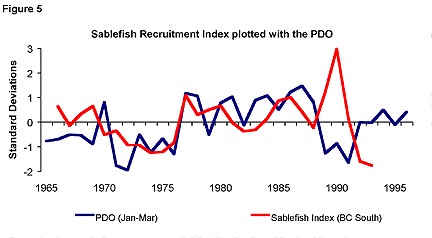Progress Report: April 1999
Project Title: Retrospective analysis of growth rate and recruitment
for sablefish, Anoplopoma fimbria, from the Gulf of Alaska and
California Current System
Principal Investigators: Steven A. Berkeley and Dudley B. Chelton, Oregon State University
The specific objectives of this retrospective study are 1) to establish
a time series of juvenile sablefish growth beginning in the 1940s, using
otoliths that have been collected from sablefish in the Gulf of Alaska and
off the west coast since the early 1980s. 2) To evaluate the correspondence
between juvenile growth and subsequent recruitment to the adult stocks of
sablefish, and the relation of these factors to year class strength in west
coast and Gulf of Alaska salmon stocks. 3) To compare and contrast growth
rates and recruitment indices between the Gulf of Alaska and west coast
stocks of sablefish. 4) To develop preliminary models of the interannual
and interdecadal response in growth and recruitment to past environmental
conditions. 5) To provide these data to other researchers to allow
development of more comprehensive models and help refine subsequent process
and monitoring studies. 6) To provide training for graduate students.
To date, we have examined 999 archived otoliths from the Gulf of Alaska
stock and 375 otoliths from the west coast stock. The oldest fish examined
to date was 88 years old. Although we have many more otoliths to examine,
we currently have a continuous time series of first year growth of Alaskan
sablefish extending back to the 1953 birth year. The average coefficient of
variation of growth within a year is 0.125. Growth rate varies greatly
among years (ANOVA, p < 0.00001). Time series of first year growth, as
inferred from otoliths, of both Alaskan and West coast sablefish are
negatively correlated with sablefish recruitment indices in both areas
(Alaska: r2 = 0.595, p = 0.0005, n = 16. West Coast:
r2 = 0.905, p = 0.051, n=6) (Figures 1 & 2). These results
suggest that sablefish growth in the first year is density dependent.


Sablefish recruitment and coho salmon production are negatively
correlated for both the West Coast (r2 = 0.168, p = 0.052, n =
23) and Gulf of Alaska (r2 = 0.280, p = 0.020, n = 19) (Figures
3 & 4). We hope to determine whether this relationship results from
direct interaction between these species (juvenile sablefish are known to
prey on juvenile salmon) or reflects species-specific differences in
response to environmental conditions. Preliminary analysis suggests that
west coast sablefish year class strength varies in phase with the Pacific
Interdecadal Oscillation (PDO), although this relationship appears to be
reversing in recent years (Figure 5).







